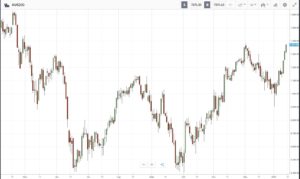It was another week of gains for the ASX200, with the index soaring 3.1% higher. Energy and the Materials sectors led gains, jumping 4.5% and 3.81%, respectively. The rise in commodity prices sent both sectors higher, with Oil, Copper and Gold all making strong gains for the week. Overseas, JPMorgan (JPM) and Bank of America (BAC) beat earnings estimates, but both banks did, however, set aside billions of dollars in loan loss revisions in anticipation of an economic slowdown.
3 things that happened last week:
1. Australian inflation rises again as Black Friday holds up retail sales
Last week, headline monthly inflation jumped to 7.3%, whilst Black Friday helped push retail sales to a monthly increase of 1.4%. In the same statement, retail sales for October were also revised, with the October data changing from a 0.2% fall to 0.4% growth. This now means sales grew every month in 2022 up to November. Inflation is still yet to peak in AU, with the expectation that Q4’s inflation reading at the end of January should show a peak of 8%. This indicates the RBA still has a lot of work to do to control inflation, which may mean they need to raise the cash rate further, which could force a recession in Australia. Reserve Bank of Australia (RBA) Governor Lowe has repeatedly stated that “we are travelling along a narrow path” in returning inflation to where it should be and avoiding a recession.
2. The World Bank forecasts a recession, what does it mean?
A global recession is worrying for investors, but they can take peace in the fact the stocks have largely priced in a moderate recession. The risks of a deep recession are low, with the housing-led recession of 2008 unlikely, especially given banks and consumers aren’t overleveraged. Causes do vary from the 2001 tech crash or other issues, like the pandemic in 2020 or the oil shock through the 1970s. The driver of recession matters. Those driven by financial crises or leverage, like in 2007, tend to cause more damage and be longer lasting than those driven by other issues. Every economic recession and resulting equity bear market is different. Recessions can be scary for consumers and are driven by fear of the unknown. But history shows the Australian economy, companies, and consumers are resilient and do eventually recover. On a global scale, markets eventually bounce back and move significantly higher over time.
3. A winner and loser last week from the S&P/ASX200
Seek Limited (SEK) shares jumped 11% last week. Although there was no direct news leading the stock higher, data from Australian Internet Vacancy Index (IVI) from Jobs & Skills Australia showed that job vacancies were at decade highs, a huge boost for the HR business.
BrainChip Holdings (BRN) shares dropped by 11%, continuing its poor run. Investors were offloading shares after the company announced a capital raising exercise.
3 things to watch for the week ahead:
1. AU Unemployment Rate – A record number of Aussies employed
In November, the unemployment rate stayed near record lows at 3.4%, and it looks set to remain at these levels for the December reading this week (19th Jan). Recession fears globally are leaving consumers pessimistic about the economy in 2023, and although the RBA looks capable of delivering a soft landing, economic growth is still expected to decline. As a result, this would likely see the unemployment rate rise in 2023 as households begin to slow down spending and businesses face uncertainty throughout the year. As of right now, though, there still remains a lot of jobs for Australian consumers. The November readings of unemployment and job vacancies showed that there was almost a job for every person currently unemployed in Australia, with 492,800 unemployed, 444,200 job vacancies and 13.77 million employed, a new record.
2. Operational updates from the materials and energy sector
The materials sector has raced out of the blocks so far in 2023, gaining more than 8% this year. With China re-opening helping to support the outlook for commodities, local mining stocks were boosted, with BHP trading at a record high. Although the materials sector has started 2023 in the green, it’s been the opposite for Santos (STO) and Whitehaven Coal (WHC) in the energy sector, with both stocks in the red. Whitehaven shares have struggled with coal prices falling to start the year on top of an abnormally warmer winter in Europe, raising question marks over demand. Some of the biggest names across the materials and energy sector will provide investors with operational updates throughout this week. BHP (BHP), Santos (STO) and Northern Star Resources (NST) on Jan. 19th, with Pilbara Minerals (PLS) and Whitehaven Coal (WHC) on the 20th. Operational updates give investors a look under the hood of production, setting the scene for their February results.
3. Netflix Q4 Earnings: Back on track
This week (20th Jan), Netflix (NFLX), a stock well-owned by Australian Investors, reports its Q4 earnings. The streaming giant enjoyed a strong end to 2022, gaining as much as 60% in the last six months of the year after a pretty dismal start. Its valuation fell significantly, trading at 15x P/E, down from the 40x it started the year at, which contrarian investors took as an opportunity to buy and were subsequently rewarded. Looking ahead to its earnings, it looks like things might finally be falling into shape for Netflix, with a solid content slate that could help to push new subscribers back above 4.5 million in the quarter, the most additions for two years. Investors’ attention though, will likely be drawn to the uptake and adoption of its new ad-supported subscription model and its outlook for 2023. Investors will also take comfort in its rising free cash flow, which looks set to end the year positive for only the second time in a decade other than its record 2020. This points to a stronger year for revenue in 2023, as well as a substantial increase in subscribers, with estimates for 14 million new users. Wall Street consensus is for Q4 earnings at USD$0.41 and revenue at USD$7.8 billion. This points to a stronger year for revenue in 2023, as well as a huge jump in subscriber growth, with estimates for 14 million new users. Wall Street consensus is for Q4 earnings at USD$0.41 and revenue at USD$7.8 billion.
*All data accurate as of 16/01/2023. Data Source: Bloomberg and eToro
Disclaimer:
This communication is general information and education purposes only and should not be taken as financial product advice, a personal recommendation, or an offer of, or solicitation to buy or sell, any financial product. It has been prepared without taking your objectives, financial situation or needs into account. Any references to past performance and future indications are not, and should not be taken as, a reliable indicator of future results. eToro makes no representation and assumes no liability as to the accuracy or completeness of the content of this publication.


